The Metal Forming Fluids Market is estimated to be valued at USD 11.0 billion in 2025 and is projected to reach USD 16.1 billion by 2035, registering a compound annual growth rate (CAGR) of 3.9% over the forecast period.
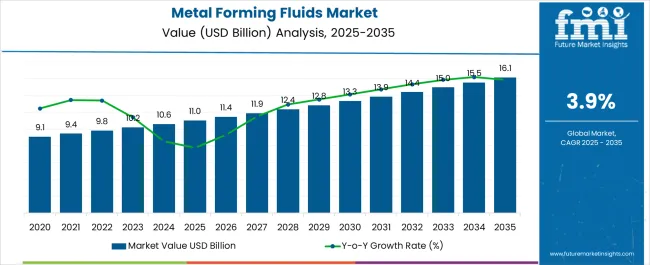
| Metric | Value |
|---|---|
| Metal Forming Fluids Market Estimated Value in (2025 E) | USD 11.0 billion |
| Metal Forming Fluids Market Forecast Value in (2035 F) | USD 16.1 billion |
| Forecast CAGR (2025 to 2035) | 3.9% |
The Metal Forming Fluids market is witnessing steady growth, driven by increasing industrialization and rising demand for precision metal forming processes across automotive, aerospace, and heavy machinery sectors. Adoption is being supported by the need to improve operational efficiency, reduce tooling wear, and enhance surface quality of finished metal components. Advancements in fluid formulations, including neat oils, soluble oils, and synthetic fluids, are enhancing lubrication, cooling, and corrosion protection, which improves process consistency and reduces downtime.
The focus on sustainability and environmental compliance is also encouraging the development of eco-friendly fluids with low toxicity and high biodegradability. Increasing adoption of automated and high-speed metal forming operations, coupled with the expansion of sheet metal stamping, forging, and extrusion applications, is further driving demand.
Investments in manufacturing infrastructure, modernization of metalworking facilities, and the need to reduce operational costs are expected to support long-term market growth Continuous innovation in fluid chemistry and delivery systems is positioning the market for sustained expansion, with solutions that optimize efficiency and product quality across diverse industrial applications.
The metal forming fluids market is segmented by product type, application, end use, and geographic regions. By product type, metal forming fluids market is divided into Neat Oils, Emulsified (Soluble) Oils, Semi-Synthetics, Water Based Emulsifiable Synthetic Fluids, and Water Based Synthetic Fluid Solutions. In terms of application, metal forming fluids market is classified into Sheet Metal Stamping, Forging, Drawing, Warm & Hot Forming, Warm & Hot Rolling, Blanking, and Coining. Based on end use, metal forming fluids market is segmented into Ferrous And Non-Ferrous Sheet Metal Stamping And Blanking Metal, Ferrous And Non-Ferrous Deep Drawing, Copper Wire Drawing, Ferrous And Non-Ferrous Cold Heading, Ferrous Fine Blanking, Ferrous Welded Tube Rolling, and Others. Regionally, the metal forming fluids industry is classified into North America, Latin America, Western Europe, Eastern Europe, Balkan & Baltic Countries, Russia & Belarus, Central Asia, East Asia, South Asia & Pacific, and the Middle East & Africa.
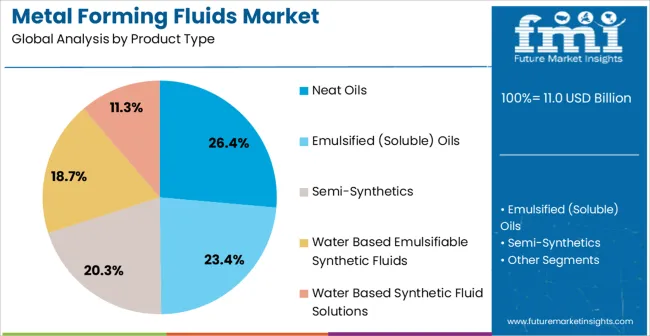
The neat oils product type segment is projected to hold 26.4% of the market revenue in 2025, establishing it as the leading product type. This segment is being driven by the superior lubrication and cooling properties of neat oils, which are critical for maintaining tool life, reducing friction, and ensuring dimensional accuracy during metal forming operations. Their simple composition and compatibility with a wide range of metals make them highly suitable for high-speed and precision processes.
Neat oils also provide cost-effective performance by minimizing fluid consumption and reducing maintenance requirements. In addition, their ability to improve surface finish and prevent oxidation and corrosion in ferrous and non-ferrous metals further strengthens adoption.
As manufacturers increasingly focus on operational efficiency, quality assurance, and cost reduction, the neat oils segment is expected to maintain its leading position Advancements in formulation technology and targeted solutions for different metalworking processes are expected to reinforce its market share, meeting the evolving needs of industrial end users.
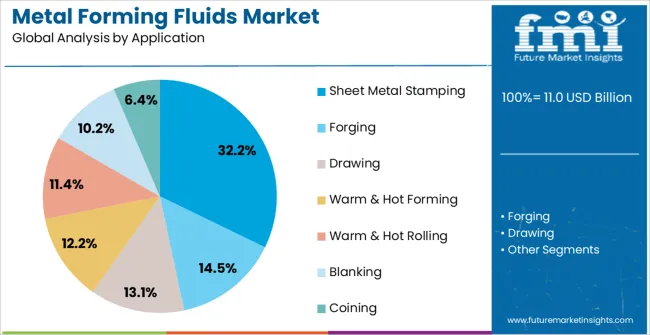
The sheet metal stamping application segment is anticipated to account for 32.2% of the market revenue in 2025, making it the leading application area. Growth is being driven by the increasing demand for high-precision components in automotive, aerospace, and consumer goods industries, where accurate stamping processes are critical. Metal forming fluids play a pivotal role in reducing friction, dissipating heat, and extending tool life during high-speed stamping operations.
The adoption of fluids that enhance process stability and product surface quality is further supporting this segment. Increasing industrial automation, expansion of large-scale manufacturing facilities, and the need for consistent production output are contributing to rising adoption.
Moreover, regulatory and quality compliance requirements are encouraging manufacturers to use optimized fluid solutions to prevent defects and ensure dimensional accuracy As demand for high-performance stamping processes grows globally, this application segment is expected to remain the primary driver of market growth, supported by continuous advancements in fluid formulation and delivery techniques.
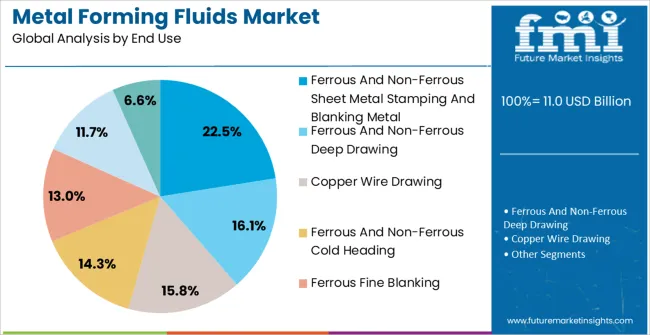
The ferrous and non-ferrous sheet metal stamping and blanking metal end-use segment is projected to hold 22.5% of the market revenue in 2025, establishing it as the leading end-use category. Growth in this segment is being driven by the increasing requirement for precision-formed metal components across automotive, electrical, and industrial machinery applications. Metal forming fluids are critical in reducing wear on stamping dies, minimizing friction, and preventing surface defects in both ferrous and non-ferrous metals.
The adoption of high-performance fluids ensures process reliability, consistent quality, and improved operational efficiency. Increasing production volumes, coupled with stringent quality standards and environmental regulations, are accelerating adoption in this end-use segment.
The ability to extend tool life, improve surface finish, and reduce downtime makes metal forming fluids essential for manufacturers in this sector As demand for high-quality, precision-formed metal components continues to rise, this segment is expected to maintain its leading position, supported by technological innovations and optimized fluid solutions for diverse metalworking applications.
Metal forming fluids find important applications in the metal forging industry. Metal forming fluids help in achieving the form and shape of different metals. There are different product ranges of metal forming fluids available for both ferrous as well as non-ferrous forming applications.
The primary purpose of metal forming fluids is to provide lubrication and cooling in metal bending, stretching and shaping operations. These fluids are usually referred to as drawing and stamping fluids.
Metal forming fluids or lubricants carry out important functions, such as lubrication, cooling and anti-corrosion. Lubrication is a very important requirement in the metal forming process as it is expected to reduce friction between the formed metal piece and the die. This is achieved through the action of metal forming fluids, which are used as a barrier to minimize the contact between the die and the work piece.
As metal forming fluids also possess anti-corrosion properties on account of anti-corrosion ingredients, they help in corrosion prevention of the final product even during storage.
The right selection of the type of metal forming fluid is based on multiple parameters which include application type, quality of water available, process type and the metal being subjected to forming. This ensures smooth and cost effective operation of the metal forming process.
For instance, in ferrous wire drawing procedures, specific metal forming fluids with the right type and quantity of additives to increase performance must be used for effective forming procedures to take place. In some cases, metals forming fluids are formulated with fatty oils, lube additives or extreme pressure agents for effective results.
Considering these important aspects of application of metal forming fluids, the study of the metal forming fluids market becomes an important read.
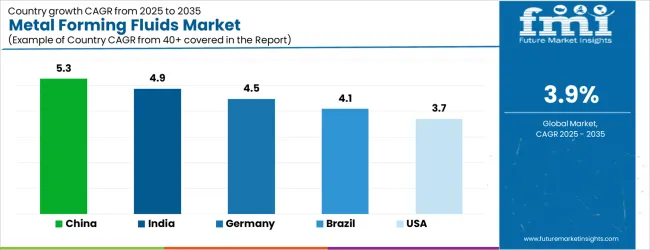
| Country | CAGR |
|---|---|
| China | 5.3% |
| India | 4.9% |
| Germany | 4.5% |
| Brazil | 4.1% |
| USA | 3.7% |
| UK | 3.3% |
| Japan | 2.9% |
The Metal Forming Fluids Market is expected to register a CAGR of 3.9% during the forecast period, exhibiting varied country level momentum. China leads with the highest CAGR of 5.3%, followed by India at 4.9%. Developed markets such as Germany, France, and the UK continue to expand steadily, while the USA is likely to grow at consistent rates. Japan posts the lowest CAGR at 2.9%, yet still underscores a broadly positive trajectory for the global Metal Forming Fluids Market. In 2024, Germany held a dominant revenue in the Western Europe market and is expected to grow with a CAGR of 4.5%. The USA Metal Forming Fluids Market is estimated to be valued at USD 4.1 billion in 2025 and is anticipated to reach a valuation of USD 4.1 billion by 2035. Sales are projected to rise at a CAGR of 0.0% over the forecast period between 2025 and 2035. While Japan and South Korea markets are estimated to be valued at USD 564.5 million and USD 373.7 million respectively in 2025.
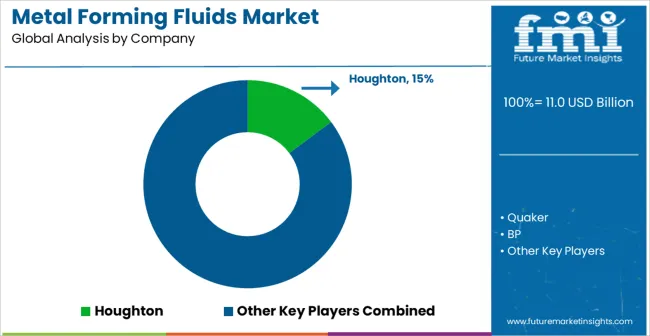
| Item | Value |
|---|---|
| Quantitative Units | USD 11.0 Billion |
| Product Type | Neat Oils, Emulsified (Soluble) Oils, Semi-Synthetics, Water Based Emulsifiable Synthetic Fluids, and Water Based Synthetic Fluid Solutions |
| Application | Sheet Metal Stamping, Forging, Drawing, Warm & Hot Forming, Warm & Hot Rolling, Blanking, and Coining |
| End Use | Ferrous And Non-Ferrous Sheet Metal Stamping And Blanking Metal, Ferrous And Non-Ferrous Deep Drawing, Copper Wire Drawing, Ferrous And Non-Ferrous Cold Heading, Ferrous Fine Blanking, Ferrous Welded Tube Rolling, and Others |
| Regions Covered | North America, Europe, Asia-Pacific, Latin America, Middle East & Africa |
| Country Covered | United States, Canada, Germany, France, United Kingdom, China, Japan, India, Brazil, South Africa |
| Key Companies Profiled | Houghton, Quaker, BP, Fuchs SE, ExxonMobil, Metalworking Lubricants, Chevron, Henkel, Milacron, Chemtool, Yushiro, Master Chemical, Blaser, and Doware |
The global metal forming fluids market is estimated to be valued at USD 11.0 billion in 2025.
The market size for the metal forming fluids market is projected to reach USD 16.1 billion by 2035.
The metal forming fluids market is expected to grow at a 3.9% CAGR between 2025 and 2035.
The key product types in metal forming fluids market are neat oils, emulsified (soluble) oils, semi-synthetics, water based emulsifiable synthetic fluids and water based synthetic fluid solutions.
In terms of application, sheet metal stamping segment to command 32.2% share in the metal forming fluids market in 2025.






Our Research Products

The "Full Research Suite" delivers actionable market intel, deep dives on markets or technologies, so clients act faster, cut risk, and unlock growth.

The Leaderboard benchmarks and ranks top vendors, classifying them as Established Leaders, Leading Challengers, or Disruptors & Challengers.

Locates where complements amplify value and substitutes erode it, forecasting net impact by horizon

We deliver granular, decision-grade intel: market sizing, 5-year forecasts, pricing, adoption, usage, revenue, and operational KPIs—plus competitor tracking, regulation, and value chains—across 60 countries broadly.

Spot the shifts before they hit your P&L. We track inflection points, adoption curves, pricing moves, and ecosystem plays to show where demand is heading, why it is changing, and what to do next across high-growth markets and disruptive tech

Real-time reads of user behavior. We track shifting priorities, perceptions of today’s and next-gen services, and provider experience, then pace how fast tech moves from trial to adoption, blending buyer, consumer, and channel inputs with social signals (#WhySwitch, #UX).

Partner with our analyst team to build a custom report designed around your business priorities. From analysing market trends to assessing competitors or crafting bespoke datasets, we tailor insights to your needs.
Supplier Intelligence
Discovery & Profiling
Capacity & Footprint
Performance & Risk
Compliance & Governance
Commercial Readiness
Who Supplies Whom
Scorecards & Shortlists
Playbooks & Docs
Category Intelligence
Definition & Scope
Demand & Use Cases
Cost Drivers
Market Structure
Supply Chain Map
Trade & Policy
Operating Norms
Deliverables
Buyer Intelligence
Account Basics
Spend & Scope
Procurement Model
Vendor Requirements
Terms & Policies
Entry Strategy
Pain Points & Triggers
Outputs
Pricing Analysis
Benchmarks
Trends
Should-Cost
Indexation
Landed Cost
Commercial Terms
Deliverables
Brand Analysis
Positioning & Value Prop
Share & Presence
Customer Evidence
Go-to-Market
Digital & Reputation
Compliance & Trust
KPIs & Gaps
Outputs
Full Research Suite comprises of:
Market outlook & trends analysis
Interviews & case studies
Strategic recommendations
Vendor profiles & capabilities analysis
5-year forecasts
8 regions and 60+ country-level data splits
Market segment data splits
12 months of continuous data updates
DELIVERED AS:
PDF EXCEL ONLINE
Metallurgical Lighting Market Size and Share Forecast Outlook 2025 to 2035
Metal Evaporation Boat Market Size and Share Forecast Outlook 2025 to 2035
Metal Miniature Bone Plates Market Size and Share Forecast Outlook 2025 to 2035
Metal Locking Plate and Screw System Market Size and Share Forecast Outlook 2025 to 2035
Metal Pallet Market Size and Share Forecast Outlook 2025 to 2035
Metal Oxide Varistor (MOV) Surge Arresters Market Size and Share Forecast Outlook 2025 to 2035
Metal Straw Market Size and Share Forecast Outlook 2025 to 2035
Metal Can Market Size and Share Forecast Outlook 2025 to 2035
Metal IBC Market Forecast and Outlook 2025 to 2035
Metalized Barrier Film Market Forecast and Outlook 2025 to 2035
Metal Packaging Market Size and Share Forecast Outlook 2025 to 2035
Metal Bellow Market Size and Share Forecast Outlook 2025 to 2035
Metal based Safety Gratings Market Size and Share Forecast Outlook 2025 to 2035
Metal Modifiers Market Size and Share Forecast Outlook 2025 to 2035
Metallic Stearate Market Size and Share Forecast Outlook 2025 to 2035
Metallic Labels Market Size and Share Forecast Outlook 2025 to 2035
Metal Recycling Market Size and Share Forecast Outlook 2025 to 2035
Metal Deactivators Market Size and Share Forecast Outlook 2025 to 2035
Metal Film Analog Potentiometers Market Size and Share Forecast Outlook 2025 to 2035
Metal Oxide Film Fixed Resistor Market Size and Share Forecast Outlook 2025 to 2035

Thank you!
You will receive an email from our Business Development Manager. Please be sure to check your SPAM/JUNK folder too.
Chat With
MaRIA